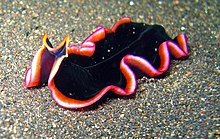Polycladida
| Polycladida | ||||||||||
|---|---|---|---|---|---|---|---|---|---|---|

|
||||||||||
| Systematics | ||||||||||
|
||||||||||
| Scientific name | ||||||||||
| Polycladida | ||||||||||
| Lang , 1884 | ||||||||||
| Submissions | ||||||||||
The order of the Polycladida ( Gr .: Vielästige ), in German sometimes referred to as sea strudel worms , comprises a group of free- living flatworms . They are mainly found in the coral reefs of the tropical seas. They get their Greek name from their richly branched and ramified intestinal tract, which is visible in many species with translucent skin. Although they have been known in zoology for around 150 years, relatively few species have been described.
features
Like all flatworms, the Polycladida are very flat and only a few millimeters thick. Since they do not have any respiratory organs or blood transport systems, all cells must be close to the surface for the exchange of substances. The length of the individuals varies between 1 mm and 30 cm. They can become relatively wide, oval in shape, and then externally resemble the marine nudibranchs from the nudibranch group .
Usually their surface is smooth, but some genera such as Acanthozoon and Thysanozoon have dorsal papillae. Tentacle-like formations of some species in the head area consist of skin folds and should not be confused with the tentacle formations or antennae formations of the nudibranchs.
The epidermis of the polycladida is often dark in color, but most of the time it appears transparent. The ovaries, shining through the skin, are red to purple in color and still give them a colorful appearance.
All flatworms have a mesodermal parenchyma that is filled with an interstitial fluid. The pressure of this liquid acts as a hydrostatic skeleton against the surrounding water pressure. This gives the flatworm's body the ability to deform and adapt to the surface of the reefs on which they live. Eyelashes on the surface of the epidermis allow them to move quickly. Larger species swim with the help of the contractions of their longitudinal and circular muscles. The edges form undulating waves like the swimming movements of marine nudibranchs.
Sense organs
The two tentacle-like folds on the head side are called "pseudotentacles". On these pseudotentacles, pigment cup oocelles lie as light-sensitive sensory organs. The most important photosensory sense organ, however, is the cerebral eye-spot, which is located above the cerebral ganglion, the "brain" of flatworms. It consists of several pigment cup-o-cells that enable brightness to be perceived and the direction of the incident light to be determined.
In addition, there are mechanoreceptors all over the body and statocysts for sensing gravity. Many chemoreceptors are mainly located in two pits at the base of the pseudotentacles. They make it possible to find food sources and partners for sexual reproduction. The flatworms are hermaphrodites.
nutrition
The polycladida are mostly carnivorous predators, they feed on sessile animals such as sponges , bryozoans , corals and colonies forming as solitary tunicates . Your pharynx can be everted and the prey can be pre-digested by protein-splitting enzymes. Some species also attack mussels and, if they occur in large numbers, endanger the aquaculture of oysters such as Stylochus matatasi from the Solomon Islands . However, some species are herbivorous and feed on green algae and diatoms .
Way of life
Polycladida occur in the littoral and sublittoral mainly in tropical waters, in which mostly the coral reefs form their habitat. They usually hunt at night to be safe from the predatory fish. During the day they hide under stones, in caves or between the colonies of sponges or tunicates that make up their food. Many species, mainly from the suborder Cotylea , can also be found during the day. They have a signal color that identifies them as inedible to their enemies. Other species operate mimicry with their striking coloring and imitate inedible nudibranchs. In the case of many species, it has not yet been investigated whether they are really inedible for fish and crustaceans ( Müller's mimicry ) or whether they only imitate inedible animals ( Bates' mimicry ). Their high ability to regenerate also offers the opportunity to survive attacks from predatory fish. If they are attacked, they often disintegrate into several parts that can regenerate again into a complete individual. However, because of this, they are difficult to catch and dissect, making systematic examination very difficult.
Types (selection)
literature
- LJ Newman, LRG Cannon and H. Govan: Stylochus (Imogene) matatasi n. Sp. (Platyhelminthes, Polycladida): pest of cultured giant clams and pearl oysters from Solomon Islands . Hydrobiologia, Volume 257, Number 3, pp. 185-189, Springer Netherlands, April 1993 ISSN 0018-8158
Web links
- Marine Flatworms of the World (English).

